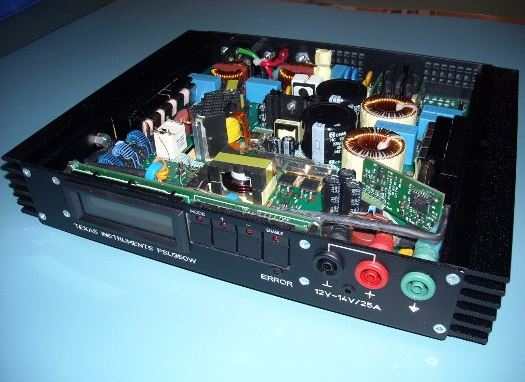
This project is a complete 350W, high performance, high-speed, offline power supply solution. It contains a novel, microcontroller-driven synchronous bridge rectifier, a 2-phase interleaved PFC stage and a phase-shifted full bridge as down converter. It has an universal input (85 265V AC) and the output voltage is adjustable between 12 and 14V. The continuous output current is 25A, the peak current is 27A. A second microcontroller monitors several values (input voltage, PFC voltage, output voltage, output current, temperatures), is the interface to the user (LCD, push-buttons), adjusts the output voltage and synchronizes the switching frequency of all converters.
Features
– Fanless & ultra slim, height 45mm
– Efficiency +93% at high line (plug-to-plug)
– 2-Phase interleaved PFC with UCC28070:
– Continuous conduction mode for low noise operation (PFC scalable to bigger power levels)
– MSP430 controlled PFC bridge rectifier (Value Line MSP430F2012)
– Synchronous Phase Shifted Fullbridge with UCC28950:
o Controller on secondary side to avoid low pass behavior of optocoupler
o Results in high loop bandwidth of +30 kHz, therefore smaller output capacitance possible
– Total System Monitoring & Control by MSP430F2252:
o AC input voltage & intermediate PFC voltage via isolated I2C-interface
o Output voltage & current
o Temperature of left/right heat sink and case temperature
o Output voltage is adjustable between 12 and 14V with a resolution of 100mV
o All controllers are synchronized by µC; switching frequency could be adjusted for
“out of RF band operation”
Includes
MSP430F2252: 16-bit ultra-low-power microcontroller, 1KB Flash, 512B RAM
TPS3809K33: 3-pin supply voltage supervisor
UCC28070: Two-phase interleaved CCM PFC controller
UCC28950: Green phase-shifted full-bridge controller with synchronous rectification
Learn more by downloading the reference design below.
Advertisement
Learn more about Texas Instruments






